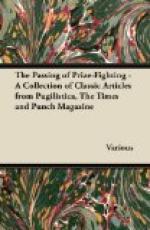* * * * *
There are certain tasks which, like virtue, carry their reward with them. No doubt Miss ELEANOUR SINCLAIR ROHDE would be gratified if her book, A Garden of Herbs (LEE WARNER), were to pass into several editions—as I trust it will—and receive commendation on every hand—as it surely must—but such results would be irrelevancies. She has already, I am convinced, tasted so much delight in the making of this, the most fragrant book that I ever read, in her delving and selecting, that nothing else matters. Not only is the book fragrant from cover to cover, but it is practical too. It tells us how our ancestors of not so many generations ago—in Stuart times chiefly—went to the herb garden as we go to the chemist’s and the perfumer’s and the spice-box, and gave that part of the demesne much of the honour which we reserve for the rock-garden, the herbaceous borders and the pergola. And no wonder, when from the herbs that grow there you can make so many of the lenitives of life—from elecampane a sovran tonic, and from purslane an assured appetiser, and from marjoram a pungent tea, and from wood-sorrel a wholesome water-gruel, and from gillyflowers “a comfortable cordial to cheer the heart,” and from thyme an eye-lotion that will “enable one to see the fairies.” Miss ROHDE tells us all, intermingling her information with mottoes from old writers and new. Sometimes she even tells too much, for, though she says nothing as to how lovage got its pretty name, we are told that “lovage should be sown in March in any good garden soil.” Did we need to be told that? Is it not a rule of life? “In the Spring a young man’s fancy....”
* * * * *
To my mind, amongst the least forgettable books of the present year will be that to which Mr. SETON GORDON, F.Z.S., has given the title of The Land of the Hills and the Glens (CASSELL). Mr. GORDON has already a considerable reputation as a chronicler of the birds and beasts (especially the less approachable birds) of his native Highlands. The present volume is chiefly the result of spare-moment activities during his service as coast-watcher among the Hebrides. Despite its unpropitious title, I must describe it without hyperbole as a production of wonder and delight. Of its forty-eight photographic illustrations not one is short of amazing. We are become used to fine achievement in this kind, but I am inclined to think Mr. GORDON goes one better, both in the “atmosphere” of his mountain pictures and in his studies of birds




